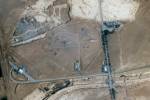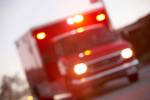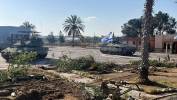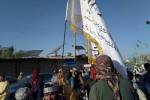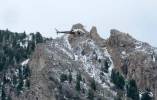Southern California may be fighting wildfires through Christmas
FALLBROOK, Calif. — A week of destructive fires in Southern California is ending but danger still looms.
Well into what’s considered the wet season, there’s been nary a drop of rain. That’s good for sun-seeking tourists, but could spell more disaster for a region that emerged this spring from a yearslong drought and now has firefighters on edge because of parched conditions and no end in sight to the typical fire season.
“This is the new normal,” Gov. Jerry Brown warned Saturday after surveying damage from the deadly Ventura County fire that has caused the most destruction and continued burning out of control. “We’re about ready to have firefighting at Christmas. This is very odd and unusual.”
Even as firefighters made progress containing six major wildfires from Santa Barbara to San Diego County and most evacuees were allowed to return home, predicted gusts of up to 50 mph through Sunday posed a threat of flaring up existing blazes or spreading new ones.
High fire risk is expected to last into January and the governor and experts said climate change is making it a year-round threat.
Overall, the fires have destroyed nearly 800 homes and other buildings, killed dozens of horses and forced more than 200,000 people to flee flames that have burned over 270 square miles since Monday. One death, so far, a 70-year-old woman who crashed her car on an evacuation route, is attributed to the fire in Santa Paula, a small city next to Ventura where the fire began.
The Ventura blaze continued to burn into rugged mountains in the Los Padres National Forest near the little town of Ojai and toward a preserve established for endangered California condors. While many evacuation orders were lifted, new ones were established as the fire grew.
Brown said he had witnessed the “vagaries of the wind” that had destroyed some houses and left others standing and expressed concern for those who lost everything.
“What can you say?” he asked. “When you lose your house and your belongings and people lose their animals, it is a horror and it’s a horror we want to minimize.”
Firefighters were on high alert for dangerous fire potential even before the first blazes broke out. On Dec. 1, they began planning for extreme winds forecast in the week ahead.
Ken Pimlott, chief of the California Department of Forestry and Fire Protection, said authorities were prepared for destruction on the level of 2003 and 2007 firestorms in Southern California and possibly those in Northern California that killed 44 people and destroyed nearly 9,000 homes and other buildings in October.
By Monday, officials had brought in fire crews from the northern part of the state as reinforcements and marshaled engines, bulldozers and aircraft.
On Tuesday, they brought in more helicopters from the National Guard and “every last plane we could find in the nation,” said Thom Porter, southern chief of the California Department of Forestry and Fire Protection.
The military provided C-130 planes for firefighting, said Mark Ghilarducci, director of the California Office of Emergency Services. More than 290 fire engines came from Montana, Utah, New Mexico, Idaho, Arizona, Oregon and Nevada.
But when flames met ferocious winds, crews were largely powerless to stop them. Even fire-attacking aircraft were helpless while being grounded at times because of night, high winds or smoke.
As fires burned in Ventura and Los Angeles counties, firefighters from other states were already in place north of San Diego on Thursday when a major fire erupted and rapidly spread in the Fallbrook area, known for its avocado groves and horse stables in the rolling hills.
“We had many resources in the area very quickly on this incident, but unfortunately within several minutes the fire had gotten out of control and well-established, and necessitated massive evacuations,” said Steve Abbott, chief of the North County Fire Protection District.
The fire swept through the San Luis Rey Training Facility, where it killed more than 40 elite thoroughbreds and destroyed more than 100 homes — most of them in the Rancho Monserate Country Club retirement community. Three people were burned trying to escape the fire that continued to smolder Saturday.
Most of this week’s fires were in places that burned in the past, including one in the ritzy Los Angeles neighborhood of Bel-Air that burned six homes and another in the city’s rugged foothills above the community of Sylmar and in Santa Paula.
The fire in Fallbrook was no exception. Ten years ago, during a deadly spate of Santa Ana wind-driven infernos, flames wiped out most of the more than 200 homes in the Valley Oaks Mobile Home Park.
Memories of that blaze were fresh as flames approached Thursday and sheriff’s deputies told residents to leave immediately.
By the time he got the order to go, Mateo Gonzalez had already helped his brother move out of his nearby place and packed all of his important belongings.
In the 2007 firestorm, Gonzalez had almost no warning before his house was destroyed, only four months after moving in.
“We weren’t prepared the first time around. This time we were,” he said Saturday, the day after he returned to his undamaged home.

























